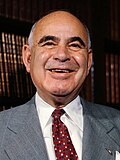| | ||||||||||||||||||||
| ||||||||||||||||||||
| ||||||||||||||||||||
 County results Lehman: 50–60% 60–70% 70–80% Dulles: 50-60% 60-70% 70–80% >90% | ||||||||||||||||||||
| ||||||||||||||||||||
| Elections in New York State |
|---|
 |
The United States Senate special election of 1949 in New York was held on November 8, 1949. On June 28, 1949, incumbent senator Robert F. Wagner resigned due to ill health. On July 7, John Foster Dulles was appointed by Governor Thomas Dewey to fill the vacancy temporarily. [1]
Contents
The Republican State Committee nominated Dulles to succeed himself. The Democratic State Committee nominated former Governor Herbert H. Lehman. The Liberal Party endorsed Lehman. The American Labor Party made no nominations and urged its members not to vote for any candidate. The Democratic/Liberal ticket was elected and Dulles was defeated. [2]

